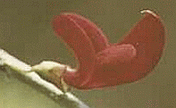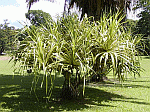
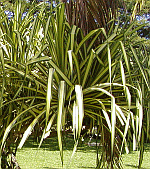
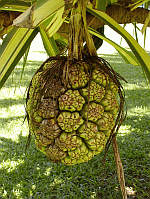
|
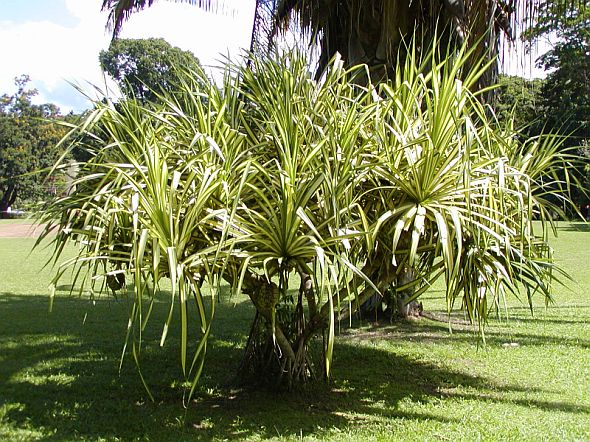
Dave Williams
Plant Family: Belongs to the Pandanaceae or Screwpine family, which includes the Common Screwpine (Pandanus utilis) and the Tahitian Screwpine (P. tectorius). This green and yellow leafed specimen appears to be P. sanderi (Timor Screwpine) rather than the similar P. veitchii (Veitch Screwpine), the latter Macmillan describes as similar but not as robust.
Description: Sun loving, evergreen, woody shrub, up to 8 m tall (25 ft); single or multiple trunks, about 20 cm in diameter (8 in), each with several aerial prop roots with conspicuous root caps, about 5 cm across (2 in); leaves linear, parallel-veined, spirally arranged at branch tips, M-shaped in cross section, up to 2 m (6 ft) or more in length, and up to 15 cm wide (6 in), green and yellow longitudinally striped, with yellow in center flanked by green, with no spiny leaf margins, as is the case with the common screwpine; compound fruit is large and aggregated, pineapple-like; the leaves of this Pandanus make it one of the most decorative of the species; and having no spines, is a more popular specimen Screwpine.
Natural Habitat: Pandanus sp. grow wild along seashores of tropical Pacific; very adaptable to tropical soil and climate conditions, but prefer hot, dry climate and well-drained soils; are salt and flood tolerant; propagated by cuttings, which root readily when placed directly in the soil.
Origin and Distribution: Pandanus sp. are native to tropical Asia; P. sanderi and P. veitchii are reportedly mutants of the Tahitian Screwpine (P. tectorius).
Uses: Dried leaves of Pandanus sp. used to weave hats, baskets, mats, and other items; dye made from sap of roots used for rock-art painting; medicinally, plant leaves used for treating inflammation by wrapping the softened leaves around the swollen spot, to create an anti-inflammatory effect.
Indigenous Legends: Popular name, Screwpine, derives from fact that leaves emerge on stem in cockscrew-like arrangement.
References:
Screwpine. Top Tropicals, Fort Lauderdale, Florida, 2005 (toptropicals.com)
H.F. Macmillan. Tropical Planting and Gardening. Macmillan, London 1956
Robert A. DeFilipps. Pandanaceae [Draft]. flora.huh.harvard.edu, n.d.
Robert A, DeFilipps. Useful Plants of the Commonwealth of Dominica, West Indies. Smithsonian Institution, Washington, D.C. 1998
|

